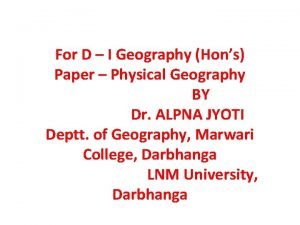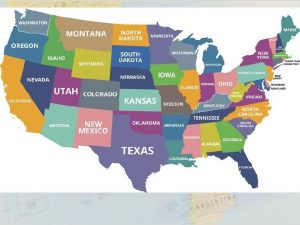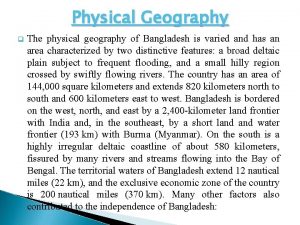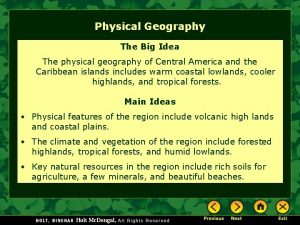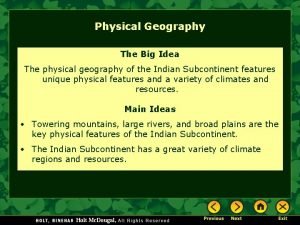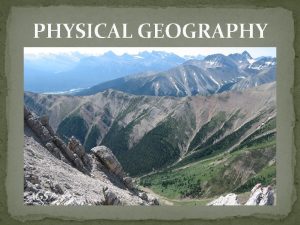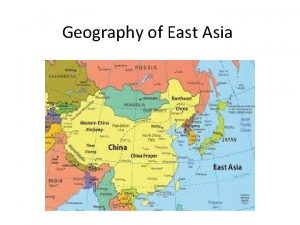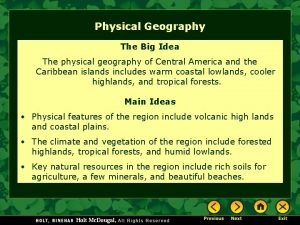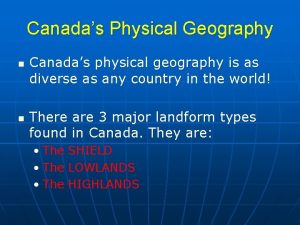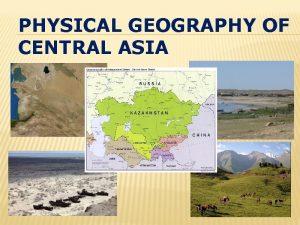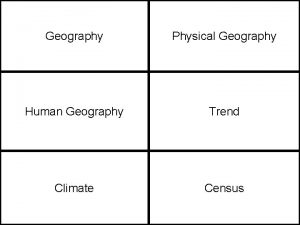For D I Geography Hons Paper Physical Geography


























- Slides: 26

For D – I Geography (Hon’s) Paper – Physical Geography BY Dr. ALPNA JYOTI Deptt. of Geography, Marwari College, Darbhanga LNM University, Darbhanga

: S M R ES O F RC D N O F A IC cy½ L á G k T c E N j I S N L k v L GE fjd O r R O U T X vk E N % O & d j C k C d I =d S T R E a ; O u N f T E s C d G FA DO ky: Ik F L N E ¼

ENDOGENETIC & EXOGENETIC FORCES v Hkwi. Vy ij ifjor. Zu ykus okyh “kf. Dr; k. Wa o cy dks v. Ur. Ztkr , oa cfg. Ztkr cy dgrs g. Sa. A v o. Slk cy ftldh m. Rifr Hkwi. Vy ds v. Unj ls gksrk g. S] v. Ur. Ztkr cy dgykrk g. SA t. Sls& Hkwd. Ei] Tokykeq[kh] v o. Slk cy ftldh m. Rifr Hkwi. Vy ds mij ghs gksrk g. S] cfg. Ztkr cy dgykrk g. SA t. Sls& unh] fgekuh] iou] leqnzh ygj vkfn. A cfg. Ztkr cy • vk. Urfjd cy

THREE MAIN CAUSES OF ENDOGENETIC FORCES i`Foh ds vk. Urfjd Hkkx esa rkih; fo’kerk ¼ Thermal extrimity in earth’s interior½ i`Foh ds vk. Urfjd Hkkx esa pêkuksa dk QSyko , oa fldq. M+u i`Foh ds vk. Urfjd Hkkx esa rjy o v)Zrjy ink. ZFkksa dk LFkkuk. Urj. k

ENDOGENETIC FORCES v. Ur. Ztkr cy ¼ Endogenetic Force½ ds nks izdkj 1½ i. Vyfo: i. kh cy ¼Diastrophic Force½ 2½ vk. Dlfed v. Ur. Ztkr cy ¼Sudden Endogenetic Force½

ENDOGENETIC FORCES • The force that comes from the earth’s interior due to any cause is called indogenetic force. • ‘Volcanic eruptions and seismic events are also the expressions of endogenetic force but such movements are called sudden movements and the forces responsible for their origin are called sudden forces. • Diastrophic force : Both vertical and horizontal movements which disfigures the earth’s crust and are caused due to forces deep within the earth are called diastrophic force also known as constructive force. It is very slow and their effect become discernible after millions of years. It covers larger areas of the globe.

ENDOGENETIC FORCES (v. Ur. Ztkr cy) i. Vyfo: i. kh cy ¼Diastrophic Force½ Epeirogenetic Force (egkns”k fuek. Z. kdkjh) Upward force Downward force Orogenetic force (io. Zr fuek. Z. kdkjh) Tension & Compress ion

ENDOGENETIC FORCES (v. Ur. Ztkr cy) Orogenetic Force (io. Zr fuek. Z. kdkjh cy) Compression (l. Eih. Mu cy) Tension (ruko) Cracking Faulting Warping & Folding

ENDOGENETIC FORCES (v. Ur. Ztkr cy) Compression (l. Eih. Mu cy) Warping (laoyu ) Upwarping Folding (aoyu ) Downwarping

ENDOGENETIC FORCES-FOLDING (v. Ur. Ztkr cy&&oyu) SYMMETRICAL FOLD (lefer oyu) ASYMMETRICAL FOLD (vlefer oyu) MONOCLINAL FOLD (, dur oyu) ISOCLINAL FOLD (leur oyu) RECUMBENT FOLD (ifjoyu) OVERTURNED FOLD (leizfr oyu) PLUNGING FOLD (voueu oyu) FAN FOLD (Ika[kk oyu) OPEN & CLOSED FOLD ([kqyk , oa c. Un oyu)

FOLD (oyu) v. Wave-like bends on the crustal rocks due to tangential compressive force resulting from horizontal movement caused by indogenetic force originating deep within the earth is known as fold. v. Indogenetic force originating deep within the earth horizontal movement compressive force crustal rock bends resulting in the shape of wave like bends known as fold.

FOLD (oyu) • In fold, some parts are bent up and some parts are bent down. • Up folded rock strata are called ‘Anticlines’ while the down fold structure in the shape of trough like feature is called ‘Synclines’. • Two sides of a fold are called ‘Limbs of the fold’. • The limb shared 1.

ANTICLINE & SYNCLINE

FOLD (oyu) • Horizontal forces and movements are known as tangential force. • The plane which bisects the angle between two limbs of anticline / middle limb of syncline is called axial plane or axis of fold. • Dip –The inclination of rock beds from the horizontal plane is called dip. • Strike –The direction of any horizontal line along a bedding plane is called strike. •

ANTICLINORIUM & SYNCLINORIUM (leiufr , oa lef. Hkufr) • Anticlinorium : Assembly of anticlines is called Anticlinorium. A series of minor anticlines in a extensive anticline is called Anticlinorium. (tc , d fo. Lr`r viufr esa vusd Nks. Vs&Nks. Vs viufr; ksa dk fuek. Z. k gks tkrk g. S] rks mls leiufr dgk tkrk g. SA ) • Synclinorium : Assembly of synclines is called Synclinorium. A series of minor synclines in a extensive syncline is called Synclinorium. (tc , d fo. Lr`r vf. Hkufr esa vusd Nks. Vs&Nks. Vs vf. Hkufr; ksa dk fuek. Z. k gks tkrk g. S] rks mls lef. Hkufr dgk tkrk g. SA )

Anticlinorium & Synclinorium

TYPES OF FOLD (oyu ds izdkj ) • Symmetrical Fold (lefer oyu ) – When both the limbs incline uniformly, the resultant fold is called symmetrical fold. It is an example of open fold but found rarely on in the field. When compressive force work regularly and with moderate intensity. • Asymmetrical Fold (vlefer oyu ) – When both the limbs incline unequal, irregular and at different angles, the resultant fold is called asymmetrical fold. One limb becomes larger and another becomes shorter. When compressive force work irregularly and with fluctuating intensity.

TYPES OF FOLD (oyu ds izdkj ) • Monoclinal Fold (, dur oyu ) – When one of the limbs incline moderately with regular slope and the another limb inclines steeply or vertical or at right angle, the resultant fold is called monoclinal fold. • Isoclinal Fold (leur oyu ) – When compressive force becomes so strong, both the limbs of the fold become parallel but not horizontal, the resultant fold is called isoclinal fold.

TYPES OF FOLD (oyu ds izdkj )

TYPES OF FOLD (oyu ds izdkj ) • Recumbent Fold (ifjofyr oyu ) – When compressive force becomes so strong, both the limbs of the fold become parallel and horizontal, the resultant fold is called recumbent fold. • Overturned Fold (izfroyu ) – Due to intense compressive force, one of the limbs of the fold is thurst upon another and become parallel but not horizontal, the resultant fold is called overturned fold.

TYPES OF FOLD (oyu ds izdkj ) • Plunge Fold (voueu oyu)– When the axis of the fold instead of being parallel to the horizontal plane becomes tilted and forms plunge angle which is the angle between the axis and the horizontal plane. • Fan Fold (ia[kk oyu)– It represents an extensive and broad fold consisting of several minor anticlines and synclines resembling a fan. Such feature is also called anticlinorium and synclinorium.

CLOSED & OPEN FOLD (c. Un , oa [kqyk oyu) • Open Fold ([kqyk oyu)– The fold in which the angle between the two limbs of the fold is more than 900 but less than 1800 (obtuse angle between the limbs of the fold. Moderate nature of compressive force make open fold. • Closed Fold (c. Un oyu)– The closed fold are those in which the angle between the two limbs of a fold as acute angle (<900). Such folds are formed because of intense compressive force.

CLOSED & OPEN FOLD (c. Un , oa [kqyk oyu)

NAPPES • Nappes are the result of comples folding mechanism caused by intense horizontal movement and resultant compressive force. • When the compressive force becomes so acute that it crosses the limit of the elasticity of the rock bed, the limbs of the fold are so acutely folded that these break at the axis of the fold and the lower rock beds come upward.

CLOSED & OPEN FOLD (c. Un , oa [kqyk oyu)

OVERTURNED FOLD
 Bsc hons adult nursing
Bsc hons adult nursing Hons clothing
Hons clothing Bsc hons in applied accounting
Bsc hons in applied accounting Bsc hons adult nursing
Bsc hons adult nursing B.ed hons secondary
B.ed hons secondary Dr séra péter
Dr séra péter English general paper paper 2 comprehension
English general paper paper 2 comprehension Aice general paper essay
Aice general paper essay Iso 22301 utbildning
Iso 22301 utbildning Typiska drag för en novell
Typiska drag för en novell Nationell inriktning för artificiell intelligens
Nationell inriktning för artificiell intelligens Vad står k.r.å.k.a.n för
Vad står k.r.å.k.a.n för Shingelfrisyren
Shingelfrisyren En lathund för arbete med kontinuitetshantering
En lathund för arbete med kontinuitetshantering Personalliggare bygg undantag
Personalliggare bygg undantag Tidböcker
Tidböcker A gastrica
A gastrica Vad är densitet
Vad är densitet Datorkunskap för nybörjare
Datorkunskap för nybörjare Boverket ka
Boverket ka Debatt mall
Debatt mall Magnetsjukhus
Magnetsjukhus Nyckelkompetenser för livslångt lärande
Nyckelkompetenser för livslångt lärande Påbyggnader för flakfordon
Påbyggnader för flakfordon Lufttryck formel
Lufttryck formel Svenskt ramverk för digital samverkan
Svenskt ramverk för digital samverkan Jag har gått inunder stjärnor text
Jag har gått inunder stjärnor text



























